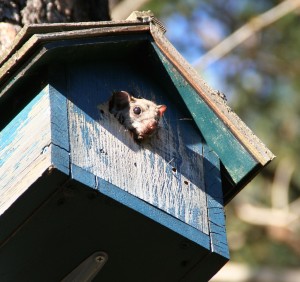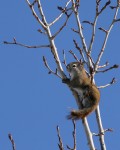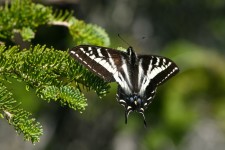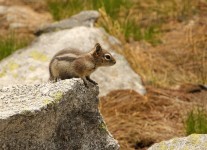A small head poked out of a bird house and it wasn’t a bird or a red squirrel–the large eyes belonged to a flying squirrel. Quickly retreating into the bird house, the flying squirrel didn’t “fly”–a feat I’m still waiting to see.

Flying squirrels have an excellent sense of hearing, smell, vision and touch since they are nocturnal.
Of course, I have to be in the right place at the right time to see a flying squirrel fly. If I had waited until after sunset, I might have seen the flying squirrel glide to another tree. Flying squirrels are nocturnal creatures, only being active a few hours after sunset and again a few hours before sunrise. They are rarely seen during the day unless disturbed.
They move about the forest by gliding between trees–they don’t fly like birds. Flying squirrels tend to launch from high up a tree and glide towards the bottom of another tree trunk. The average glide is 65 feet but gliding between trees on a downhill slope can stretch the glide to 300 feet.
In winter, flying squirrels will land in the snow and leave a distinct impression with tracks leading to the nearest tree.
Several features allow flying squirrels to glide. Most notable is the patagia–the skin membrane between the front and hind legs. When gliding, the flying squirrel can stretch the patagia out like a parachute.
The patagia is supported by stiff pieces of cartilage attached to the wrist and an extensive muscle network. During a glide, limb movement can modify the muscle network to change the patagia formation from barely open to a billowing parachute.
A “mini-patagia” between the neck and wrists helps lessen turbulence, generate forward acceleration and lift.
The combination of limb movement and a flat, rudder-like tail allow flying squirrels to steer in a semicircular fashion. During flight they can zig-zag like a slalom skier making it harder for predators (and humans) to track them.
Flying squirrels can even turn 180 degrees in midair and return to the same tree they launched from–a feat that changed the idea that flying squirrels were passive gliders.
Instead, flying squirrels are active gliders able to control their glide and landings. They can adjust a piece of cartilage on the outside of their wrist (like wing tips on jets) to control lift, speed, distance, and trajectory of a glide.
Controlling their glide is pertinent when it comes to landing instead of colliding with a tree trunk. Before landing, flying squirrels change their angle from a horizontal gliding position to an upright position to slow down. They push all their limbs forward so they hit the tree trunk with all four feet simultaneously.
Once landed, the flying squirrel quickly dashes to the opposite side of the tree to avoid any aerial predators in pursuit. Great horned owls are their primary predators but they also have to contend with other owls, hawks, marten, weasels, coyotes and domestic cats. A furry tail is often all that remains after a great horned owl catches a flying squirrel.
Flying squirrels are most vulnerable when they are foraging for mushrooms on the forest floor. The majority of the flying squirrel’s diet is found within the tree canopy but they stray onto the forest floor to harvest mushrooms and truffles. They eat a variety of nuts, conifer cones, seeds, fungi, lichens, tree sap and the occasional dead animal, insect and bird egg.
Flying squirrels forage year-round, giving us chance to see them in flight if we can find them.




